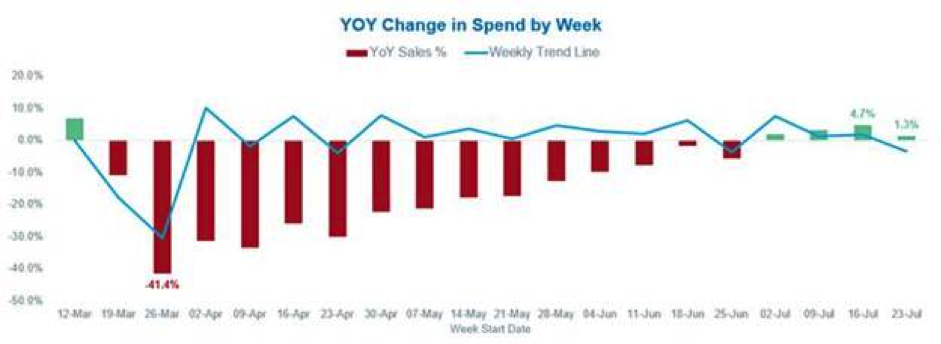UK consumer spending experienced its first year-on-year increase since the beginning of the lockdown as pent up consumer demand helped the economy show early signs of a tentative rebound, according to Cardlytics’ July State of Spend Report.
Spending growth peaked at +5% during the week commencing 16 July compared to the same period last year, before levelling out at +1% in the week commencing 23 July – the point at which consumers were required to wear face coverings in all shops and shopping centres.
 These figures represent a significant recovery from a spending low of -41% in the week lockdown was introduced in March (w/c 26 March).
These figures represent a significant recovery from a spending low of -41% in the week lockdown was introduced in March (w/c 26 March).
The breaking up of schools in July led consumers to splash out on toys (+29%) and sports and outdoor equipment (+22%) to keep kids active and entertained in the holidays, benefitting brands like Lego, Smyths Toys, Decathlon and Go Outdoors. Meanwhile an increase in new family pets during lockdown likely drove the spike in spending on pet supplies in July at the likes of Pets at Home (+19%).
Spend on home and garden (+35%) and office supplies (+29%) continued to go from strength to strength in July, outperforming last year by almost a third, as consumers refined their working from home set-ups and used the good weather to renovate their homes and gardens.
Duncan Smith, Commercial Director, Cardlytics, commented: “After months of uncertainty, businesses may well be breathing a sigh of relief as UK consumer spending in July showed its first signs of year-on-year growth since the start of lockdown. It is a positive landmark of recovery but cannot be applauded too soon. As the furlough scheme begins to wind down and unemployment rises, so will consumer anxiety in the months to come which will impact how much and how frequently we spend.
“There’s a clear opportunity for brands to appeal to new and different consumer groups or even re-brand themselves and their offer, as we all adapt to a new normal of spending. Consumers are gradually willing to start spending again, and a combination of pent-up demand, more confidence buying online, and new interests picked up during lockdown could prove to be a major help for the UK retail industry.”
However, when it comes to discretionary non-essential spending, recovery has been more cautious. Spend at low-ticket, high-frequency businesses such as health and beauty retailers, cinemas, fashion retailers and restaurants, continues to fall short of last year. In the last week of July, discretionary spend was down -6% year-on-year.
Eat Out to Help Out
Despite restaurants and hotels opening for customers in July, the outlook for hospitality and travel industries remained challenging. Spend on Hotels (-24%), Pubs (-41%), Airlines (-50%) and Casual Dining (-67%) continued to be well below year-on-year figures in July.
However, early data from August shows positive signs of recovery in the sector thanks to the impact of the Government’s Eat Out to Help Out scheme. In the first week of the scheme, both total spending and the number of customer visits in the dining sector jumped by 11% week-on-week.
Total spend in the dining sector continued its streak of growth for all three weeks of the scheme, with pubs the standout winners. Spend in pubs recovered to pre-pandemic levels (0%) in the third week of the scheme, while visits were up 11% compared with last year.
Duncan Smith, added: “There’s no doubt that the Eat Out to Help Out scheme has successfully got cautious consumers off their couches and back into restaurants, pubs and cafes as discounts proved too enticing to resist after months of lockdown.
“But the dining sector is not out of the woods yet. Overall visits continue to be down on last year and, in some areas, like London, the picture is even tougher. The real test of whether the Eat Out To Help Out scheme has been a success will come in September when restaurants can no longer rely on Government funded discounts, to keep their tables full. No one in the restaurant industry wants to see Consumer demand becoming dependent on 50% discounts so we’re working with companies to target offers that tier incentives based on customer propensity to spend with their brand. This allows them to maximise the impact of their marketing budgets as we ween consumers off unsustainable discount levels.”

